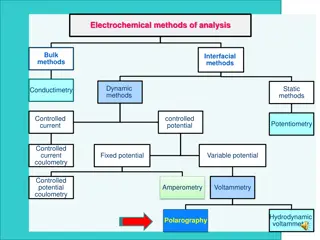Understanding Potentiometry and Electrochemical Cells
Electrochemical cells play a vital role in redox reactions, with potentiometry being a quantitative analysis method based on measuring potentials. These cells consist of two half-cells where reduction and oxidation take place, forming anode and cathode. Reference electrodes like calomel and Ag/AgCl ensure stability. Indicator electrodes change potential according to the solution composition. Metal and membrane electrodes are examples. Overall, potentiometry offers a detailed understanding of ion analysis in solutions through electrochemical processes.
Download Presentation

Please find below an Image/Link to download the presentation.
The content on the website is provided AS IS for your information and personal use only. It may not be sold, licensed, or shared on other websites without obtaining consent from the author. Download presentation by click this link. If you encounter any issues during the download, it is possible that the publisher has removed the file from their server.
E N D
Presentation Transcript
POTENTIOMETRY POTENTIOMETRY
Electrochemical cells are the cells which are subject to redox reactions. There is a need to electron transfer to redox reaction to form potential in these cells. Potentiometry is a method based on measurement of the potential. Potentiometry is a quantitative analysis of ions in the solution using measured potentials in an electrochemical cell formed with a reference electrode and a suitable indicator electrode. Potentiometry is an electrochemical analysis method that can be applied where a suitable colored indicator is not possible (for example, in dark or very dilute solutions). This method can also be used for the analysis of two or more different components. Indicator electrode potentials cannot be measured absolutely, but the potential difference between them is measured by comparing the potential of the reference electrode. Electrochemical Cells; 1. Galvanic cells: Cells in which electrical current occurs as a result of chemical reactions 2. Electrolytic cells (electrolysis cells): Cells where chemical reactions occur as a result of the application of electrical current from the outside.
Each cell is composed of two semi-cells on which reduction and oxidation occur. Each half cell is called an electrode. The electrode on which reduction occurs is called cathode, and the electrode on which oxidation occurs is called anode. An anode or a cathode reaction never can walk alone; there is an oxidation in the presence of a reduction or a reduction in the presence of an oxidation. In this way, electron current can be generated. In order for a current to flow through a cell, the electrodes must be connected to each other by a metallic conductor from outside, and the solutions in the two cells must be in contact with each other, which is provided by a salt bridge. Figue 1. Electrochemical cell
Reference Electrode It is potentially stable and is not affected by the applied external potential. An ideal reference electrode should have the following characteristics: 1. It should be reversible and suitable for Nerst equality 2. There is a potential that does not change with time. 3. It turns back to the original potential after being exposed to a small current 4. It should not be affected by temperature change. Examples of reference electrode are calomel and Ag / AgCl. (a) (b) Figure 2. Scheme of calomel electrode (a) and Ag / AgCl electrode (b)
Indicator Electrode (Working Electrode) Indicator electrodes are the ones whose potential changes in accordance with the solution composition and they are used with reference electrode. The potential of the electrode is influenced and changed by the applied external potential. Membrane electrodes (glass electrode, ion selective electrodes etc.) and metal electrodes are examples of indicator electrode. Metal Electrodes: Elements such as Ag, Cu, and Cd that form irreversibly oxidizing ions are used in the determination of their ions. Membran Electrodes: These electrodes are sensitive to certain ions. The most important of these is the glass electrode. Glass electrode is sensitive to H+ ions and used for pH measurement. In a balloon made up from a special glass generally includes with a certain concentration 0.1 M HCl solution and the Ag / AgCl electrode is immersed in the solution. This potential is due to the difference between the two solutions. This potential is read against the reference electrode. The potential difference depends on the pH of the solution. This relation is given below: eglass=e glass 0.0591 log aH+=e glass + 0.0591 pH (25 C)
The emf that is occurred on this electrode is E = eAg + eglass+ ecalomel In this equation eAg and eglass are constant so potential is directly depended on eglass. It is possible to determine pH value by calculating eglass. In the pH meter, the pH scale is graded from 0 to 14, but due to the alkali and acid errors, the glass electrode works best between pH 1-10. Things to watch out for using glass electrode; - Very precise and careful handling is required. - It should be stored in a saturated KCl solution. - The electrode should not be immersed in dehydrating solvents such as ethanol, sulfuric acid, and in the glass-soluble hydrophobic acid solutions or concentrated alkaline solutions. - Electrodes should never be washed with organic solvents. Figure 3. Scheme of glass electrode
Potentiometric Titration: Potentiometry is an electroanalytical method which is also used in titration processes. In this method, titration is performed without using an indicator. Because there is no suitable indicator for the titration of some substances and it can degrade in the environment. In the potentiometric titration; the measured potential or pH is plotted against the volume of the titrant. The first and second derivatives of the titration curve are calculated so that the equivalence point can be determined more clearly. Experimental Procedure: Before starting the experiment, the pH meter should be calibrated with a basic and acidic buffer solutions. Acid (10 mL HCl) is transferred to a beaker, added 30 mL distilled water to increase volume. The solution is stirred with magnetic stirrer. First, pH value is recorded with pH meter. Burette is filled with standart NaOH solution. Then NaOH is added on the acid solution in equal portions. pH is measured after each addition and the added titrant is plotted versus pH. The instantaneous increase in pH indicates the equivalence point. After reading all the values, a titration curve is obtained and found the molarity of HCl. The first and second derivative curves are plotted in order to determine precisely the turning point of the curve. Figure 4. Potentiometric titration curve
As a result of the experiment, first of all, the pH values are plotted versus each mL volume of titrant. But the turning point from this graph cannot be read accurately. For this reason, the first derivation of the graph is calculated. . Graph of ?? ?=??2 ??1 ?2 ?1 versus volume of NaOH (V). Figure 5. First derivative of potentiometric titration curve Again, the equivalence point in this chart may not be clearly defined. For this reason, it is necessary to take a second derivative. ??/ ? ? = 2?? ?2 versus volume of NaOH (V) Graph of Figure 6. Second derivative of potentiometric titration curve
References 1. Fundamentals of Analytical Chemistry, D.A. Skoog, D.M. West, Hollar, F.J. Crouch S.R., IIX. Ed. 2004 2. Principles of Instrumental Analysis, D.A. Skoog, Hollar, F.J. Crouch S.R., II. Ed. 1981 3. Analitik Kimya II, F. Onur, A. . Eczac l k Fak ltesi Yay nlar No. 101, 2011 4. Analitik Kimya Pratikleri Kantitatif Analiz, F. Onur (Ed.), A. . Eczac l k Fak ltesi Yay nlar No. 111, 2014 5. Ettre, L.S. & Sakodynskii, K.I. Chromatographia (1993) 35: 223. https://doi.org/10.1007/BF02269707 6. Tswett M. Physical chemical studies on chlorophyll adsorptions. Ber Dtsch Bot Ges 1906;24:316-23. 7. Analytical Electrochemistry, J. Wang, 3rd Ed. John Wiley and Sons, 2006 8. Practical Electrochemical Cells. In: Handbook of Electrochemistry, S. Chen, Ed.: Zoski, C. G., Amsterdam: Elsevier, 33 56, 2007 9. Fundamentals of Electroanalytical Chemistry, P. Monk, John Waley-Sons Inc., 2011
























